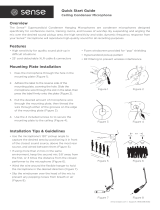
dEScRIPtIon dEScRIPtIon
C314 MANUAL C314 MANUAL42 43
The overload display also indicates minimal overloads
(fractions of a second). When reaching or exceeding
approximately 2 dB below the admissible headroom,
the active polar pattern LED turns red for approximately
onetoveseconds,dependingonthesoundlevel.To
prevent overloads, increase the preattenuation with
selector 2 or increase distance to the sound source.
This function is not only used to prevent mixers but
alsotheinternalamplierfromoverloading,which
would increase noise and distortion.
Selector for bass cut
Figure 3: Selector for bass cut
Theswitchablebasscut(seeg.3)helpstoreduce
distortions at extremely low frequencies, which may
occurduetohandlingorwind.Thelterslope12dB/
octave, at cut-off frequency of 100 Hz. The bass cut
also minimizes the proximity effect that may arise when
close-in miking from less than 6 inches (15 cm).
Stereo pairs
Realistic stereo recordings require microphones with
outstanding performance and excellent quality. They
also require consistent performance and accurate
localization throughout the entire frequency range from
the pair of microphones.
Therefore, every factory-matched pair of C314 is
created from thousands of individual microphones
selected by AKG’s sophisticated computer-aided
matching method.
The C314 matched stereo pairs thus provide the
highest possible correlation over the microphones’
entire frequency range and virtually identical sensitivity
for stunning, three-dimensional recordings.
Stereo pairs
















